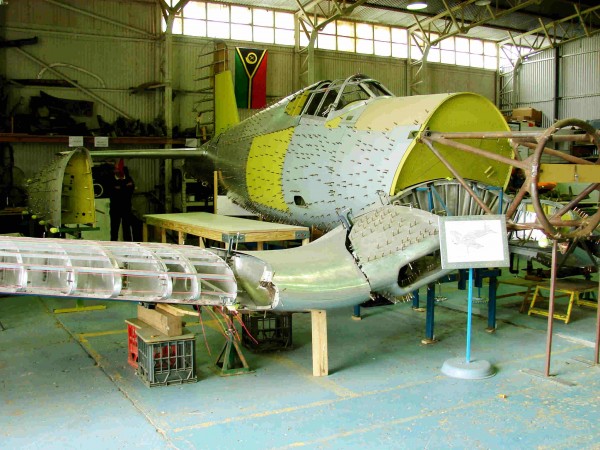
Warbirds News has received a couple of nice photographs we’d like to share showing current progress on the Chance-Vought F4U-1 Corsair under restoration at the Classic Jets Fighter Museum near Adelaide, Australia. This aircraft, Bu.No.02270, is the oldest Corsair in preservation and according to the number stamped into the upper main spar cap on the starboard side, the 124th example produced by Vought. It is also one of only two surviving “birdcage” canopy variants of the breed.
Bob Jarrett, who runs the Classic Jets Fighter Museum first set eyes on this Corsair back in 1987. It was lying in a salt water lagoon on a South Pacific island in what was once known as the New Hebrides, but is now the nation of Vanuatu. The VMF-321 Corsair had force-landed in that lagoon following operations on May 5th, 1944 with Captain James Vittitoe USMC at the controls. He was returning from a long training mission with several dozen other aircraft, but ran out of fuel just short of his home base at Quoin Hill. Vittitoe survived the war and lived until 1994. He wrote a short account of his life and times, which makes for interesting reading here. Two other VMF-321 Corsairs suffered a similar fate on the day Vittitoe crashed, and one of them is located in shallow water nearby to where his aircraft ended up. It is more or less complete, but extremely fragile, and would probably fall apart if disturbed.
Bu.02270 was a well known tourist attraction, and had suffered heavily from both the elements and vandalism in the decades since the war. As Bob Jarrett states, when CJFM was looking to acquire the wreck in 2009, “The Corsair had really started to deteriorate to the point of total loss. Examination of the aircraft showed that the main fuselage section had been cut away at sometime, leaving the totally corroded engine and the entire wing section remaining in the water.
The forty-one foot wing had to be disassembled into three sections for floating ashore. All the wing fold hinges were rusted solid underwater, so one wing at a time was lifted on a bush tripod and lifting blocks, out of the water for cutting through with oxy equipment.
When we had all three sections floated ashore, we positioned them on clear land for exposure to tropical sun and rain which eliminated the weed life and millions of small shells. The landowner, Eric Tom, performed further cleaning of the wings over the following months.
We had the wing sections transported to Efaté and loaded into a 40 foot shipping container. Upon settlement with the landowner and with export permits cleared, the Corsair container made its way by ship to Adelaide, South Australia and finally to the Classic Jets Fighter Museum, where work commenced immediately on assessing and planning the restoration.”
CJFM operates on a shoestring budget, but has made relatively quick work on restoring their Corsair to static condition. Components salvaged from a few other South Pacific wrecks have also found their way into the project, along with parts sourced from further afield. They have no set date for completing their work, but estimate the Corsair will be ready for painting sometime in 2016. The museum’s efforts depend heavily upon their cadre of volunteers, which has proven itself admirably on several previous major restorations like their P-38 Lightning and P-39 Airacobra. The museum has built up a magnificent collection of rare types over the years and is a must see for any warbird enthusiast visiting Australia. Please click here to learn more.


























